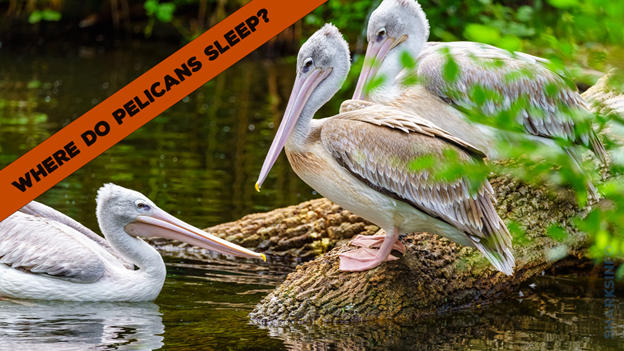Pelicans are one of the most interesting and unique seabirds in the world. Their long throat pouch and large bodies make them instantly recognizable, and their fishing habits are fascinating to watch. However, despite global distribution, you hardly get to see them in their natural habitat.
Being water-dependent, these alluring creatures spend most of their time in the aquatic environment, making it even more difficult for humans to get to know the species. There are a total of eight living species found worldwide, and not all of them come to the shore. In order to capture a glimpse and to take pictures, people look for sleeping behavior. Well, this article is going to look exactly into that, along with a brief overview of the types of Pelicans.
Where do Pelicans sleep?
Birds typically sleep in their nests, which are usually made in trees or on the ground. However, when it comes to pelicans, you will find them resting on rafts or floating platforms. There are species of pelicans that you will also find sleeping on trees, just like the other birds.
How do Pelicans sleep?
The sleeping habits of pelicans are the same regardless of the species or where they are sleeping. It is common for most of them to sleep on land, either standing on both feet or lying on their backs and stomachs. After positioning their bulky bodies, they rest their heads on one shoulder while leaning their beaks to one side.
Scientific Classification
They can be scientifically classified into:
| Kingdom | Animalia |
| Phylum | Chordata |
| Class | Aves |
| Order | Pelecaniformes |
| Family | Pelecanidae |
| Genus | Pelecanus |
Types of Pelicans
There are about eight species of pelicans found in different parts of the world, with the exception of Antarctica.

| S.No | Common name | Scientific name | Size (feet) | Weight (kg) | Conservation status |
|---|---|---|---|---|---|
| 1 | Brown Pelican | P. occidentalis | Body (4.6), Wingspan (6.5 – 7.5) | 3.5 – 4.5 | Least concern |
| 2 | American White Pelican | P. erythrorhynchos | Body (4 – 6), Wingspan (8 – 9.5) | 5 – 9 | Least concern |
| 3 | Peruvian Pelican | P. thagus | Body (5), Wingspan (8.1) | 7 | Near Threatened |
| 4 | Great White Pelican | P. onocrotalus | Body (4.5 – 5.8), Wingspan (8 – 9.8) | 10 – 11 | Least concern |
| 5 | Australian Pelican | P. conspicillatus | Body (5.2 – 6.2), Wingspan (7.5 – 8.2) | 4 – 8 | Least concern |
| 6 | Pink-backed Pelican | P. rufescens | Body (4 – 4.3), Wingspan (8.5 – 9.5) | 4 – 7 | Least concern |
| 7 | Dalmatian Pelican | P. crispus | Body (5.2 – 6), Wingspan (9 – 10.5) | 10 – 12 | Near Threatened |
| 8 | Spot-billed Pelican | P. philippensis | Body (4.2 – 5), Wingspan (8.2) | 5 | Near Threatened |
7 Awesome Facts About Pelicans
Here, we are enlisting 7 interesting facts about pelicans.
- Pelicans are large water birds with distinguishing pouches under their beak.
- With maturity, adult pelicans are better at gauging their chances of hunting success, which leads to them catching their prey more often.
- Pelicans typically eat fish, but they have also been known to eat amphibians, reptiles, and even small mammals.
- They often hunt in groups, scooping up prey with their large beaks.
- Pelicans are social birds, and they can often be seen gathered in large groups near bodies of water.
- Pelicans are excellent swimmers, and they have been known to dive from heights in order to catch fish.
- It is estimated that they live between 10 and 30 years in the wild, though some individuals may live longer.
Conclusion
In spite of the fact that pelicans have several species, all of them possess the famous throat pouch for which they are most well-known. It is a social bird and typically travels in flocks along coastlines and lakes. When it comes to sleeping, most species form their nets on the ground, while a few rests on rafts while standing on both feet. The fact, such as their distinctive pouch, makes people wonder about their fascinating features and attributes and compel us all to learn more about the species.







